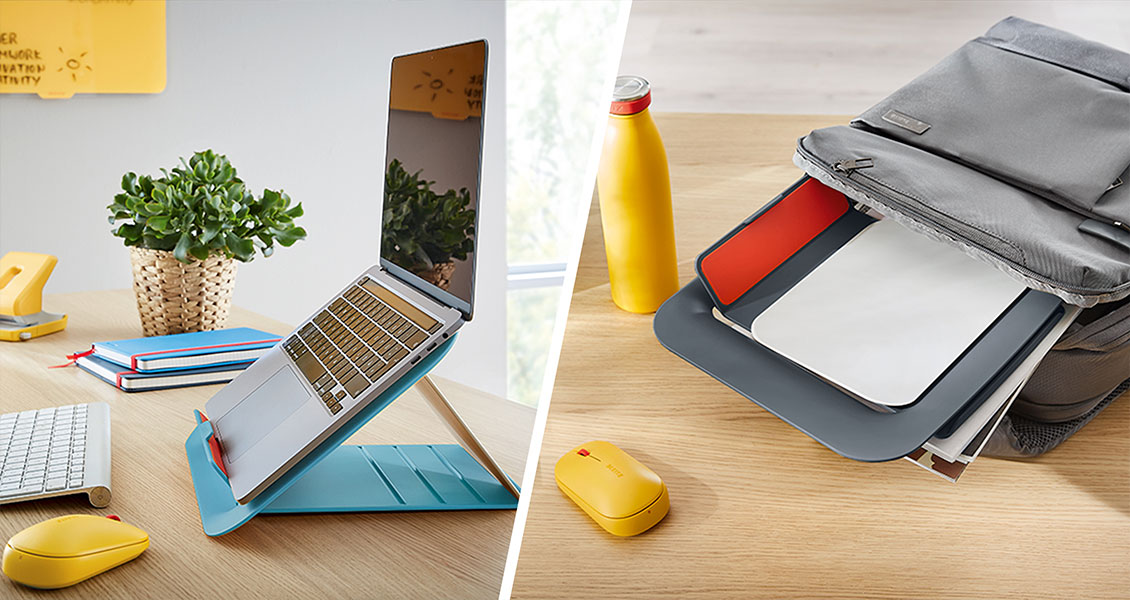10 Ways to Create the Best Hybrid Working Environment
25.05.2023

Long gone are the days of working in an office full-time. The past few years have changed the way in which businesses operate around the world. Working from home, initially a practice implemented out of necessity, has stuck and individuals have adapted to remote working. A recent survey shows that for employees that can work from home, the most common practice is hybrid working.
Companies have recognised the improved work life balance that comes from working from home, which comes with better employee wellbeing and productivity. Another survey shows that 90% of employees are as productive or more productive when they work remotely when compared to the office. A hybrid working model helps to facilitate the contrasting desires of staff, with some wanting to remain at home and others preferring to work on-site in the office.

What is hybrid work?
Hybrid working aims to provide employees and businesses with the best of both worlds. This blended model sees employees spending some of the working hours in the office and some working from home. The split may depend on the individual or the business. Commonly, employees will spend two or three days a week working from home, and the remaining time in the office.
Hybrid working allows businesses and employees to benefit from the flexibility of remote working, while still maintaining an established base of operations. It has become the way in which many businesses worldwide are now operating.
Flexibility has become paramount for workers and business owners have had to establish hybrid office spaces to accommodate this. However, there are benefits for companies too, which include:
- Access to a wider talent pool
- Fewer businesses costs
- Efficient and streamlined processes
- Staff taking fewer sick days
- Happier and highly productive employees
- Increased staff retainment
Equally, along with flexibility and an improved work life balance, the choice to work from home or the office has meant employees:
- Have more family time
- Don’t have to spend time or money commuting
- Communicate internally effectively
- Have stronger colleague relationships
- Can work from any location
- Feel satisfied, which equals increased productivity
How can companies facilitate hybrid working for employees?
Whilst the benefits of hybrid working are clear, how can companies put them into practice? Below, we highlight our top 10 considerations when developing a hybrid working strategy.
1) Plan for different working environments
Make the best use of different working environments by scheduling collaborative and creative projects for the office and save conceptual and project work whilst at home with fewer distractions.
It can be helpful for teams to have at least one or two days a week where everyone will be in the office, to allow for collaborative working.
2) Schedule meetings effectively
Be mindful when booking meetings. Remember that staff will be both in the office and at home, so be sure to run all meetings via video chat software regardless of who is in or out of the office. This means nobody will miss any communication.

3) Invest in portable equipment
Employees who embrace the hybrid working model will need to be able to move seamlessly between their home and the office. Investing in portable office equipment is key to making this as easy as possible for these individuals.
Laptops are key, so a protective laptop case will be needed. Employees will also need a wireless computer mouse and perhaps an external keyboard.
You should also bear in mind ergonomics when equipping your employees. A portable laptop stand will elevate an employee’s screen to an appropriate viewing height, to help them work comfortably. Our Leitz Ergo Cosy laptop stand folds flat when not in use, so it’s ideal for transporting between home and the office.
4) Elevate hot desks
Turn hot desks into shared workspaces with all the equipment and comfort of a permanent desk. Employees should be able to sit at any desk and have everything they need to work effectively and productively.
Consider the basic equipment individuals will require. It may include scissors, tape dispenser, waste paper bin, stapler, and hole punch. Giving everyone what they need on every hot desk workspace will help to support productive and efficient working.
You could also communicate a process to employees, so they can tidy their hot desk at the end of the working day. It might involve putting equipment back and cleaning up any rubbish and paperwork that’s accumulated throughout the day. A desk organising unit can help to keep hot desks tidy.

5) Address employee health
Introduce air purifiers to help kill airborne viruses and ensure better indoor air quality. Poor office air quality can particularly affect members of staff with asthma or other respiratory issues. Staff who are otherwise well may exhibit the following symptoms due to polluted office air:
- Itchy and/or runny eyes
- Runny nose
- Sneezing
- Swollen sinuses
- Difficulties breathing
- Cough
- Itchy or sore throat
Leitz’s range of TruSens Air Purifiers come in three sizes to suit your workplace. TruSens Air Purifiers improve indoor air quality and don’t only focus on dust, dirt, and gasses. You can utilise one of our filters (pet, odour, or allergy and flu) depending on what suits the office space best.
If employee health is your aim, the Allergy and Flu filter is what you need for your office. It captures 99.99% of airborne viruses and allergens, including coronavirus. With our TruSens Air Purifiers and HEPA filters, you can reduce the risk of illness in your office and help your employees to breathe cleaner, fresher air.
6) Communicate data protection requirements
Data protection rules apply when an employee is working from home as well as when they are in the office. You should ensure individuals know what is expected from them in terms of data protection and the processes they should follow to avoid a breach.
This could involve not allowing employees to take paperwork home with them. Instead, they can scan paperwork to the cloud and access it from home that way. They should also be asked to be aware of who might be around when they discuss confidential information on phone calls or video meetings and take steps to not be overheard.
When in the office, employees should ensure any paperwork with confidential information is properly destroyed. A paper shredder is the best way to do this. Leitz has a range of smart and quiet paper shredders, with sizes available for all offices. Whether you need micro cut shredders or cross cut shredders, all our paper shredders have a high security level to ensure you’re compliant with data protection regulations.

7) Create collaboration spaces
Repurpose permanent desk spaces and create break-out areas to encourage collaboration. Many companies no longer have a set desk structure for members of staff, instead adopting hot desking and shared workspaces to aid the hybrid working ethos.
If you find your office now has spare desk space, turn it into an area where people can get together to discuss projects. This can help people to make the most of their time in the office and being around other people, so they can then use their working from home time for solo work.
8) Invest in the necessary software
It’s imperative that your staff can access everything they need, whether they’re working from the office or from another location. Therefore, you should make sure your business is equipped with the necessary software to do this.
It could mean moving your files and drives to a cloud-based system where individuals need to just log in to access what they need. It might also require moving to an online project management system, to make sure everyone can keep on top of their tasks and can communicate effectively.
You should also ensure you have suitable communication software, so all your employees can keep in contact. This could be a messaging system such as Microsoft Teams or Slack, with different channels set up for various teams and projects. This will allow everyone to communicate each other, no matter where they are working from.
9) Develop a home-style working environment
Create a home from home by adding contemporary furniture and accessories with a splash of colour to ensure a relaxed and productive environment. The Leitz WOW and Leitz Cosy range are collections of office accessories and office storage solutions to help keep offices organised. Available in a variety of bold or calming colours to complement your workplace, the collections boast products such as filing equipment, storage boxes, letter trays and ergonomic equipment.

10) Host events and activities
Encourage social interaction by communicating activities and events around the office as well as digitally for those at home. Weekly virtual quizzes are a great way to have fun with colleagues and are easily accessible for those both working from home and in the office.
You could also organise in-person meetings a few times a year. This could involve team-building activities or a more relaxed dinner. Informal events can help to strengthen the bonds between colleagues and improve communication when at work.
Building a hybrid office
Creating a hybrid work model is not a quick process. It involves planning, input from employees, and implementation. It is important to get everybody on board when moving towards a hybrid working model to understand the different requirements of all teams and departments. Whilst this may sound like a daunting task, by using the 10 tips outlined above combined with research and preparation, you can create a hybrid working method that helps individuals create a working structure that best suits their needs.
Leitz has a huge range of office equipment and home office essentials for productive and efficient working.
Read more about hybrid working:
Tips to Work Productively When Hybrid Working
Data Protection and Working from Home: Tips to Work Securely